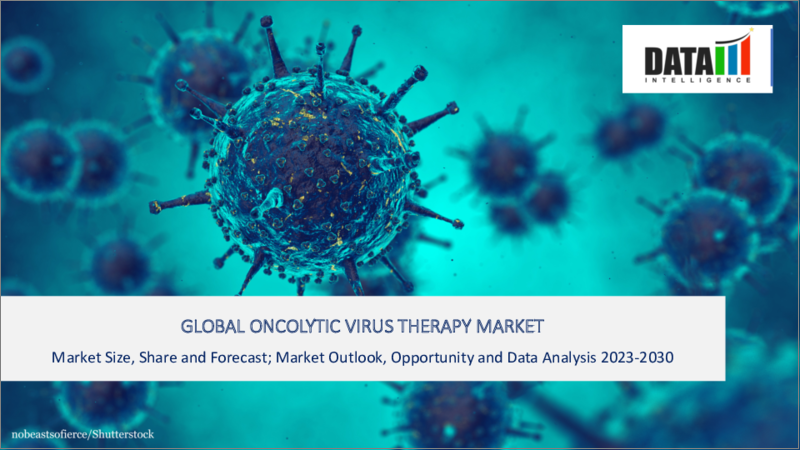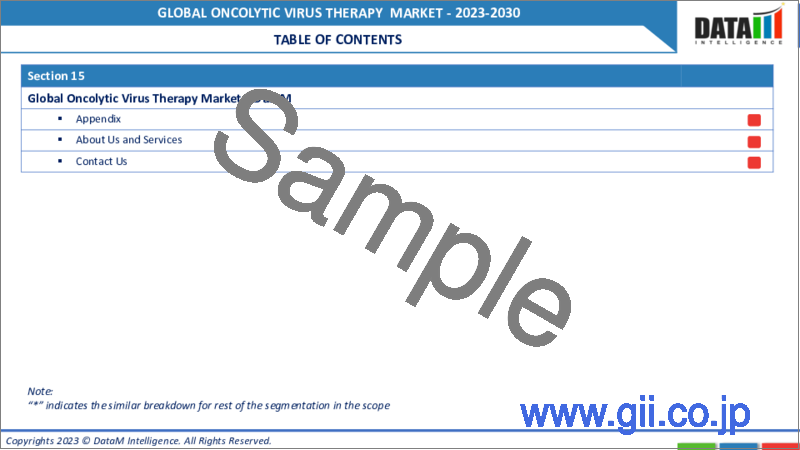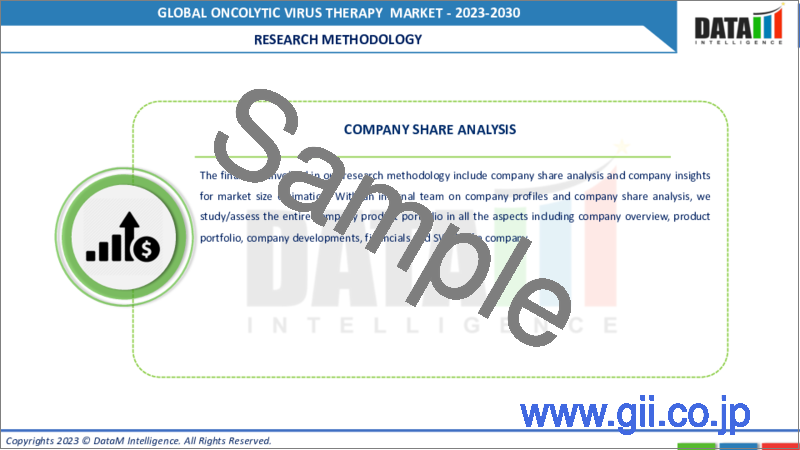|
|
市場調査レポート
商品コード
1143413
腫瘍溶解性ウイルス療法の世界市場-2022-2029Global Oncolytic Virus Therapy Market - 2022-2029 |
||||||
|
● お客様のご希望に応じて、既存データの加工や未掲載情報(例:国別セグメント)の追加などの対応が可能です。 詳細はお問い合わせください。 |
|||||||
| 腫瘍溶解性ウイルス療法の世界市場-2022-2029 |
|
出版日: 2022年10月26日
発行: DataM Intelligence
ページ情報: 英文 200 Pages
納期: 約2営業日
|
- 全表示
- 概要
- 目次
市場概要
腫瘍溶解性ウイルス療法市場は、予測期間(2022年~2029年)にCAGR19.32%で成長すると予測されています。
腫瘍溶解性ウイルスは、遺伝子操作されたウイルスまたは自然発生ウイルスで、選択された用語を模倣し、正常な組織を傷つけずにがん細胞を死滅させることができます。腫瘍溶解性ウイルス療法は、がん治療のための新しい治療アプローチであり、世界的に有望な結果を示しています。
市場力学
がん患者の増加や、腫瘍溶解性ウイルスなどのがん治療法の開発の増加が、世界の市場成長の原動力となっています。
がん患者数の増加と臨床研究が、世界の腫瘍溶解性ウイルス治療市場の成長を促進しています。
がん症例の増加と、腫瘍溶解性ウイルス療法に関する臨床研究の増加が、世界の市場成長を後押ししています。例えば、Clinical Trials.Govによると、10件の介入型臨床研究が行われています。Govによると、10の介入型臨床研究が活発に行われています。そのうちのいくつかは、メソジスト病院研究所が主催する、転移性トリプルネガティブ乳がんおよび転移性非小細胞肺がんにおける定位体放射線療法とin situ腫瘍溶解性ウイルス療法の第II相機会損失試験で、2023年11月に終了する予定です。米国国立がん研究所(NCI)主催の難治性大腸がんに対するペクサベック腫瘍溶解性ウイルスと免疫チェックポイント阻害剤の併用による第1/2相試験(2023年6月終了予定)、ジェネラックス株式会社主催の再発または難治性卵巣がん患者に対するGL-ONC1オンコルト免疫療法の第1b&第2相試験(VIRO-15)(終了予定:2022年12月)があることです。
さらに、WHOの統計によると、2020年のがんによる死亡者数は1000万人で、約6人に1人ががんで死亡しています。そのうち、約70%は低・中所得国で発生しており、最も多いがんの種類は、乳がん(2020年226万件)、肺がん(2020年約221万件)、結腸・直腸がん(2020年193万件)です。
高コストと免疫反応が市場の成長を抑制しています。
がん治療のために治療薬を繰り返し投与することによる、ウイルスベースの治療薬に対する免疫反応は、市場の成長を阻害する重大な要因となっています。腫瘍溶解性ウイルス療法の高コストは、特に新興国において市場成長にさらに影響を及ぼします。
COVID-19の影響
COVID-19は、改善された機会を創出することで、市場にプラスの影響を及ぼしました。例えば、COVID-19は、より良い結果を得るために、バイオテクノロジー的に改良された製品に焦点を合わせるよう舵を切りました。パンデミックの中、多くのバイオ医薬品業界は、SARS-CoV-2の治療と診断のために、パンデミックを克服するために、さまざまなバイオテクノロジー的に改良されたワクチンを開発しました。さらに、バイオテクノロジーデバイスは、パンデミックとの戦いの様々な段階で役立っています。COVID-19パンデミックは、より良いヘルスケアシステムのためのバイオテクノロジーソリューションに目を向けさせ、これは免疫毒素市場に肯定的な影響を及ぼしたのです。
セグメント分析
メラノーマセグメントは、予測期間(2022-2029年)中、世界市場を独占すると想定されています。
メラノーマは、皮膚メラノーマの負担が増加していること、また、現在FDAが皮膚メラノーマの治療用として、腫瘍細胞に感染しその破壊を促す単純ヘルペスウイルス(HSV)を改変した腫瘍溶解性ウイルス療法、T-VEC(Imlyg)を承認するなど、新製品の承認により予測期間中(2022-2029)世界市場を独占すると予想されます。また、WHOの発表によると、世界では毎年200万から300万人の非黒色腫皮膚がん、13万2千人の黒色腫皮膚がんが発生しています。皮膚がん財団の統計によると、アメリカ人の5人に1人が一生のうちに皮膚がんを発症すると言われています。オゾン層が破壊されると、大気はその保護フィルター機能をますます失い、より多くの太陽紫外線が地表に届くようになります。オゾンレベルが10%減少すると、メラノーマ以外の皮膚がんが30万人、メラノーマが4,500人増えると推定されています。世界がん研究基金インターナショナルによると、皮膚メラノーマは世界で17番目に多いがんであり、2020年には新たに15万人以上のメラノーマ患者が発生しています。皮膚がん財団によると、米国では毎日9,500人以上の人が皮膚がんと診断されています。
地域分析
北米地域は、世界最大の腫瘍溶解性ウイルス治療市場を保持しています。
北米は、2021年に世界のオンコリティック皮膚がん市場を独占しました。この地域では、研究開発への注力と支出の増加、北米の主要な市場プレイヤーの存在とともに、がんの負担が増加しているため、予測期間(2022年~2029年)を通して支配的であると推定されます。国立がん研究センターによると、2020年には1,806,590人が新たにがんと診断され、606,520人ががんで死亡したと登録されています。また、米国がん協会によると、2021年には約190万人が診断され、60万8,570人のがんによる死亡が確認されています。CDCによる予測では、2040年には年間の新規がん患者数は2,950万人に増加するとされています。さらに、北米は最も堅牢で高度な医療インフラを有し、より良い医療費償還政策も備えているため、予測期間中、北米が世界市場を独占するのに役立っています。
競合情勢
腫瘍溶解性ウイルス療法は、アムジェン、上海サンウェイバイオテック、RIGVIRなど、少数の主要プレイヤーに高度に集中しています。業界の企業は低利益率で経営しており、予測期間中にさらに悪化する可能性があります。業界各社は、市場でのプレゼンスを拡大するために、無機的な成長戦略の実施に注力しています。例えば、2022年1月11日、アムジェンとArrakis Therapeuticsは、新規RNA分解剤低分子治療薬の特定に向けて共同開発しました。
アムジェン社
概要
アムジェン社は、1980年に設立され、カリフォルニア州サウザンドオークスに本社を置く多国籍バイオ医薬品のリーディングカンパニーです。アムジェン社は、分子生物学および生化学製品の研究・製造に注力しており、組換えDNA技術に基づくヘルスケア事業の提供を目標としています。
製品ポートフォリオ
アムジェン社の腫瘍溶解性ウイルス治療の製品ポートフォリオには、単純ヘルペスウイルス1型の弱毒化型であるIMLYGIC(talimogene laherparepvec)があります。
世界の腫瘍溶解性ウイルス治療市場レポートでは、約40以上の市場データ表、45以上の図、200ページ(概算)の範囲でのアクセスを提供することになります。
目次
第1章 調査手法と調査範囲
- 調査手法
- 調査目的および調査範囲
第2章 市場の定義と概要
第3章 エグゼクティブサマリー
第4章 市場の力学
- 市場影響要因
- 促進要因
- 研究開発
- がん患者の増加
- 抑制要因
- 高コスト
- 免疫反応
- ビジネスチャンス
- 影響分析
- 促進要因
第5章 産業分析
- ポーターのファイブフォース分析
- サプライチェーン分析
- 規制分析
- パイプライン分析
第6章 COVID-19の分析
- COVID-19の市場分析
- COVID-19以前の市場シナリオ
- COVID-19の現在の市場シナリオ
- COVID-19の後、または将来のシナリオ
- COVID-19の中での価格ダイナミクス
- 需要-供給スペクトラム
- パンデミック時の市場に関連する政府の取り組み
- メーカーの戦略的取り組み
- まとめ
第7章 薬効分類別
- オンキシ-15
- タリモジェンラヘルパレップベック
- レオリジン
- リグビル
- その他
第8章 用途別
- メラノーマ
- 卵巣がん
- 乳がん
- その他
第9章 治療法タイプ別
- HSVを用いた腫瘍溶解性ウイルス
- アデノウイルス系がん治療用ウイルス
- ワクシニアウイルス系抗がん剤
- 水疱性口内炎ウイルスベースの腫瘍溶解性ウイルス
- ニューカッスル病ウイルス由来腫瘍溶解性ウイルス
第10章 地域別
- 北米
- 米国
- カナダ
- メキシコ
- 欧州
- ドイツ
- 英国
- フランス
- イタリア
- スペイン
- その他欧州
- 南米
- ブラジル
- アルゼンチン
- その他の南米地域
- アジア太平洋地域
- 中国
- インド
- 日本
- オーストラリア
- その他アジア太平洋地域
- 中東・アフリカ地域
第11章 競合情勢
- 主な展開と戦略
- 企業シェア分析
- 製品ベンチマーク
第12章 企業プロファイル
- Amgen Inc.
- 企業概要
- 製品ポートフォリオと説明
- 主なハイライト
- 財務概要
- Shanghai Sunway Biotech Co. Ltd
- RIGVIR
第13章 DataM
Market Overview
Oncolytic Virus Therapy Market is expected to grow at a CAGR of 19.32% in the forecast period (2022-2029).
An oncolytic virus is a genetically engineered or naturally occurring virus that can imitate selected terms and kill cancer cells without harming normal tissues. Oncolytic Virus therapy is a new therapeutic approach for treating cancer and has shown promising results globally.
Market Dynamics
The rising prevalence of cancer cases and increasing development of cancer-treating therapies such as an oncolytic virus is driving the market growth globally.
The increasing number of cancer cases and clinical research propel the global oncolytic virus therapy market growth.
The growing cases of cancer and increasing clinical research on oncolytic virus therapy fuel the global market growth. For instance, according to the Clinical Trials. Gov, 10 interventional clinical studies are active; a few of them are Phase II window of opportunity trial of stereotactic body radiation therapy and in situ oncolytic virus therapy in metastatic triple-negative breast cancer and metastatic non-small cell lung cancer followed by Pembrolizumab sponsored by The Methodist Hospital Research Institute and estimated to be finished by November 2023, a phase I/II study of Pexa-Vec oncolytic virus in combination with immune checkpoint inhibition in refractory colorectal cancer sponsored by National Cancer Institute (NCI) and expected to be finished by June 2023 and a phase 1b & 2 study with GL-ONC1 oncolytic immunotherapy in patients with recurrent or refractory ovarian cancer (VIRO-15) sponsored by Genelux Corporation and completion date estimation is December 2022.
Furthermore, per the WHO statistics, cancer accounted for 10 million deaths in 2020, about 1 in 6 deaths from cancer. Out of which, around 70% of deaths occurred in low- and middle-income countries; the most common type of cancer are breast (2.26 million cases in 2020), lung (around 2.21 million cases in 2020), and colon & rectum cancers (1.93 million cases in 2020).
The high cost and immune reaction restrain the growth of the market.
The immune reaction to the virus-based therapies by repeated administration of therapeutics for treating cancer is a critical restraint hampering the market growth. The high cost of oncolytic virus therapy further affects market growth, especially in developing countries.
COVID-19 Impact
COVID-19 had a positive impact on the market by creating improved opportunities. For instance, COVID-19 has steered our focus towards biotechnologically modified products to achieve better results. Amidst the pandemic, many biopharmaceutical industries developed different biotechnologically modified vaccines to treat and diagnose SARS-CoV-2 to win over the pandemic. Moreover, biotechnological devices have helped in the various stages of fighting the pandemic; the COVID-19 pandemic has made us look at biotechnological solutions for a better healthcare system, which had an affirmative effect on the immunotoxin market.
Segment Analysis
The melanoma segment is assumed to command the global market throughout the forecast period (2022-2029).
Melanoma is expected to dominate the global market during the forecast period (2022-2029) owing to the growing burden of skin melanoma and new product approvals, such as FDA currently approved an oncolytic virus therapy for the treatment of skin melanoma, T-VEC (Imlygic), a modified herpes simplex virus (HSV) that infects tumor cells and promotes their destruction. Also, as per the WHO, annually 2 to 3 million non-melanoma skin cancers and 132,000 melanoma skin cancers occur globally. One in every three cancers diagnosed is a skin cancer; according to Skin Cancer Foundation Statistics, one in every five Americans will develop skin cancer in their lifetime. As the ozone levels are depleted, the atmosphere loses more and more of its protective filter function, and more solar UV radiation reaches the Earth's surface. An estimated 10 percent decrease in ozone levels will result in an additional 300,000 non-melanoma and 4,500 melanoma skin cancer cases. According to the World Cancer Research Fund International, skin melanoma is the 17th most common cancer worldwide; there were more than 150,000 new melanoma cases in 2020. In reference to the Skin Cancer Foundation, in the U.S., more than 9,500 people are diagnosed with skin cancer every day.
Geographical Analysis
The North American region holds the largest global oncolytic virus therapy market.
North America dominated the global oncolytic skin cancer market in 2021. It is estimated to dominate throughout the forecast period (2022-2029) since there is a growing burden of cancer in this region, along with the increased focus and spending on research and development and the presence of key market players in North America. According to the National Cancer Institute, in 2020, 1,806,590 new cases were diagnosed, with 606,520 deaths registered of cancer. In addition, in 2021, around 1.9 million were diagnosed, and 608,570 deaths were confirmed of cancer, as per the American Cancer Society. According to the projection by CDC, new cancer cases per year will rise to 29.5 million by 2040. Moreover, North America has the most robust and advanced healthcare infrastructure, along with better healthcare cost reimbursement policies, which helps North America to dominate the global market during the forecast period.
Competitive Landscape
Oncolytic virus therapy is highly concentrated among a few key players, such as Amgen, Shanghai Sunway Biotech Co. Ltd, and RIGVIR. Companies in the industry operate on low-profit margins, which are likely to worsen further during the forecast period. Industry players are focusing on implementing inorganic growth strategies to expand their presence in the market. For instance, on 11 January 2022, Amgen and Arrakis Therapeutics collaborated to identify novel RNA degrader small molecule therapeutics.
Amgen Inc.
Overview:
Amgen Inc. is a leading multinational biopharmaceutical company founded in 1980 and headquartered in Thousand Oaks, California. Amgen Inc. is focused on research and manufacturing molecular biology and biochemistry products; its goal is to provide a healthcare business based on recombinant DNA technology.
Product Portfolio:
The product portfolio of Amgen Inc. for oncolytic virus therapy has IMLYGIC (talimogene laherparepvec) is a weakened form of Herpes Simplex Virus Type 1.
The global oncolytic virus therapy market report would provide access to approximately 40+ market data tables, 45+ figures, and in the range of 200 (approximate) pages.
Table of Contents
1. Methodology and Scope
- 1.1. Research Methodology
- 1.2. Research Objective and Scope of the Report
2. Market Definition and Overview
3. Executive Summary
4. Market Dynamics
- 4.1. Market Impacting Factors
- 4.1.1. Drivers
- 4.1.1.1. Research and Development
- 4.1.1.2. Increasing Prevalence of Cancer Cases
- 4.1.2. Restraints
- 4.1.2.1. High Cost
- 4.1.2.2. Immune Reaction
- 4.1.3. Opportunity
- 4.1.4. Impact Analysis
- 4.1.1. Drivers
5. Industry Analysis
- 5.1. Porter's Five Forces Analysis
- 5.2. Supply Chain Analysis
- 5.3. Regulatory Analysis
- 5.4. Pipeline Analysis
6. COVID-19 Analysis
- 6.1. Analysis of Covid-19 on the Market
- 6.1.1. Before COVID-19 Market Scenario
- 6.1.2. Present COVID-19 Market Scenario
- 6.1.3. After COVID-19 or Future Scenario
- 6.2. Pricing Dynamics Amid Covid-19
- 6.3. Demand-Supply Spectrum
- 6.4. Government Initiatives Related to the Market During Pandemic
- 6.5. Manufacturer's Strategic Initiatives
- 6.6. Conclusion
7. By Drug Class
- 7.1. Introduction
- 7.1.1. Market Size Analysis, and Y-o-Y Growth Analysis (%), By Drug Class
- 7.1.2. Market Attractiveness Index, By Drug Class
- 7.2. Onxy-15
- 7.2.1. Introduction
- 7.2.2. Market Size Analysis, US$ Million, 2021-2029 and Y-o-Y Growth Analysis (%), 2021-2029
- 7.3. Talimogene laherparepvec
- 7.4. Reolysin
- 7.5. RIGVIR
- 7.6. Others
8. By Applications
- 8.1. Introduction
- 8.1.1. Market Size Analysis, and Y-o-Y Growth Analysis (%), By Application
- 8.1.2. Market Attractiveness Index, By Application
- 8.2. Melanoma
- 8.2.1. Introduction
- 8.2.2. Market Size Analysis, US$ Million, 2021-2029 and Y-o-Y Growth Analysis (%), 2021-2029
- 8.3. Ovarian Cancer
- 8.4. Breast Cancer
- 8.5. Others
9. By Therapy Type
- 9.1. Introduction
- 9.1.1. Market Size Analysis, and Y-o-Y Growth Analysis (%), By Therapy Type
- 9.1.2. Market Attractiveness Index, By Therapy Type
- 9.2. HSV-based Oncolytic Viruses
- 9.2.1. Introduction
- 9.2.2. Market Size Analysis, US$ Million, 2021-2029 and Y-o-Y Growth Analysis (%), 2021-2029
- 9.3. Adenoviruses-based Oncolytic Viruses
- 9.4. Vaccinia Virus-based Oncolytic Viruses
- 9.5. Vesicular Stomatitis Virus-based Oncolytic Viruses
- 9.6. Newcastle Disease Virus-based Oncolytic Viruses
10. By Region
- 10.1. Introduction
- 10.1.1. Market Size Analysis, US$ Million, 2021-2029 and Y-o-Y Growth Analysis (%), 2021-2029, By Region
- 10.1.2. Market Attractiveness Index, By Region
- 10.2. North America
- 10.2.1. Introduction
- 10.2.2. Key Region-Specific Dynamics
- 10.2.3. Market Size Analysis, and Y-o-Y Growth Analysis (%), By Drug Class
- 10.2.4. Market Size Analysis, and Y-o-Y Growth Analysis (%), By Application
- 10.2.5. Market Size Analysis, and Y-o-Y Growth Analysis (%), By Therapy Type
- 10.2.6. Market Size Analysis, and Y-o-Y Growth Analysis (%), By Country
- 10.2.6.1. The U.S.
- 10.2.6.2. Canada
- 10.2.6.3. Mexico
- 10.3. Europe
- 10.3.1. Introduction
- 10.3.2. Key Region-Specific Dynamics
- 10.3.3. Market Size Analysis, and Y-o-Y Growth Analysis (%), By Drug Class
- 10.3.4. Market Size Analysis, and Y-o-Y Growth Analysis (%), By Application
- 10.3.5. Market Size Analysis, and Y-o-Y Growth Analysis (%), By Therapy Type
- 10.3.6. Market Size Analysis, and Y-o-Y Growth Analysis (%), By Country
- 10.3.6.1. Germany
- 10.3.6.2. The U.K.
- 10.3.6.3. France
- 10.3.6.4. Italy
- 10.3.6.5. Spain
- 10.3.6.6. Rest of Europe
- 10.4. South America
- 10.4.1. Introduction
- 10.4.2. Key Region-Specific Dynamics
- 10.4.3. Market Size Analysis, and Y-o-Y Growth Analysis (%), By Drug Class
- 10.4.4. Market Size Analysis, and Y-o-Y Growth Analysis (%), By Application
- 10.4.5. Market Size Analysis, and Y-o-Y Growth Analysis (%), By Therapy Type
- 10.4.6. Market Size Analysis, and Y-o-Y Growth Analysis (%), By Country
- 10.4.6.1. Brazil
- 10.4.6.2. Argentina
- 10.4.6.3. Rest of South America
- 10.5. Asia Pacific
- 10.5.1. Introduction
- 10.5.2. Key Region-Specific Dynamics
- 10.5.3. Market Size Analysis, and Y-o-Y Growth Analysis (%), By Drug Class
- 10.5.4. Market Size Analysis, and Y-o-Y Growth Analysis (%), By Application
- 10.5.5. Market Size Analysis, and Y-o-Y Growth Analysis (%), By Therapy Type
- 10.5.6. Market Size Analysis, and Y-o-Y Growth Analysis (%), By Country
- 10.5.6.1. China
- 10.5.6.2. India
- 10.5.6.3. Japan
- 10.5.6.4. Australia
- 10.5.6.5. Rest of Asia Pacific
- 10.6. Middle East and Africa
- 10.6.1. Introduction
- 10.6.2. Key Region-Specific Dynamics
- 10.6.3. Market Size Analysis, and Y-o-Y Growth Analysis (%), By Drug Class
- 10.6.4. Market Size Analysis, and Y-o-Y Growth Analysis (%), By Application
- 10.6.5. Market Size Analysis, and Y-o-Y Growth Analysis (%), By Therapy Type
11. Competitive Landscape
- 11.1. Key Developments and Strategies
- 11.2. Company Share Analysis
- 11.3. Product Benchmarking
12. Company Profiles
- 12.1. Amgen Inc.
- 12.1.1. Company Overview
- 12.1.2. Product Portfolio and Description
- 12.1.3. Key Highlights
- 12.1.4. Financial Overview
- 12.2. Shanghai Sunway Biotech Co. Ltd
- 12.3. RIGVIR
LIST NOT EXHAUSTIVE
13. DataM
- 13.1. Appendix
- 13.2. About Us and Services
- 13.3. Contact Us




